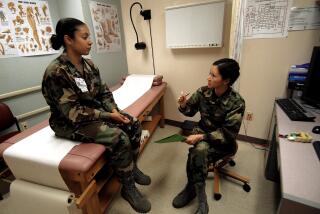How Whole Departments Fail A Hospitals Patients
- Share via
Brenda Nelson hurried though the doors of Martin Luther King Jr./Drew Medical Center in October, toting a container of gumbo soup for her son, Mario. She expected him home soon.
To her surprise, she was told that Mario, 28, was in intensive care. There, a security guard repeatedly refused to let her in. When she finally was allowed through an hour later, nobody told her what she would find.
Mario was dead, his eyes and mouth open.
“I screamed and hollered,” she said recently, her hands trembling. “I tried to pull my baby out of the bed.”
Then she closed his eyes.
A nurse told Nelson that Mario — the family’s chief party planner and cook, and a onetime church choir director — had suffered from AIDS, something she hadn’t known. The immediate cause of death was respiratory failure brought on by pneumonia.
What Nelson was not told, until The Times reported it five days later, was that the nurse assigned to keep constant watch over Mario had not. She had silenced the alarm on his vital-signs monitor, then failed to notice his heartbeat fading, according to the nurse’s suspension letter filed in her Civil Service records.
Nor was Nelson told that the nurse had allegedly falsified her son’s medical chart. According to Los Angeles County health officials, the nurse indicated that she found Mario stable at 6 p.m. — more than an hour after he had died.
“She took it in her hands to play God,” said Nelson, who has sued the county, which owns King/Drew.
Mario’s death was no isolated incident. Three King/Drew patients, all hooked up to monitors, died last year after nurses failed to notice their declining vital signs, state and federal inspectors found.
The nursing department is often considered the heart of a hospital; its failings alone can incapacitate the entire institution. The frequency of lapses in King/Drew’s nursing department suggests a systemic problem, one that goes beyond mere individual shortcomings.
In fact, a Times investigation found that such deep failings extend well beyond nursing, to at least three other areas.
Mistakes and neglect at times have debilitated King/Drew’s pharmacy and doctor-training programs, which affect nearly every patient admitted. And the newspaper found the small but essential department of orthopedic surgery to be crippled by employee misbehavior — absenteeism, profiteering, even the commission of felonies in off hours.
The fault, hospital experts say, lies with the institution’s overall leadership.
Unless leaders can identify and fix what is broken, a hospital cannot operate safely, said Dr. Donald Berwick, president of the Boston-based Institute for Healthcare Improvement. Otherwise, he said, it’s like insisting, “My car is fine except for the brakes.”
Until recently, the Los Angeles County Board of Supervisors, King/Drew’s governing body, has balked at wholesale repairs. Over the years, as the evidence has piled up in audits, malpractice cases, internal memos and reports from regulators, the board has largely stood by, seemingly paralyzed.
“Fundamentally, someone has to step up to the plate and lead the people out of the morass that they’re in,” said Dr. Kenneth W. Kizer, president of the National Quality Forum, a nonprofit group seeking to improve healthcare.
Orthopedic surgery
Orthopedic surgeons are the carpenters of medicine, called in to repair limbs shattered by bullets or snapped in car wrecks. They tend to the aching joints of the elderly and the torn ligaments of the weekend warriors.At King/Drew, they also quite often get into trouble.
It starts at the top.
Dr. Clarence Woods, department chief until his removal this fall, was twice faulted by county auditors for having little or no control over his staff — including surgeons and physician assistants who often worked only when they wanted to.
Dr. William T. Long, the only other full-time orthopedic surgeon, recently resigned after being threatened with dismissal for allegedly falsifying his time cards and referring insured King/Drew patients to his private practice at Centinela Hospital Medical Center in Inglewood. Auditors found him performing surgeries and seeing private patients at Centinela on at least five Fridays this year when his time card indicated he was at King/Drew.
Long said the county dropped its allegations against him before he resigned. “I was not found to be at fault for anything when I left there,” he said.
Department of Health Services officials said they could not comment on personnel matters.
Dr. James K. Brannon, a high-profile surgeon and medical entrepreneur, is under investigation by county auditors for alleged conflicts of interest.
Although he works just part time at King/Drew, the doctor has ordered nearly $1 million in medical equipment for surgeries there from a company he co-owns. The disposable items, used for bone grafts, are far more expensive than the reusable devices employed by most hospitals, orthopedic surgery experts told The Times.
Brannon has denied wrongdoing, saying he ordered his company’s equipment with the full approval of the county.
The department’s surgeon-training program is so rife with troubles that the county plans to phase it out at the urging of the national accrediting group for physician-training programs.
In a recent letter to the hospital, the Accreditation Council for Graduate Medical Education said King/Drew’s orthopedic surgery residents were badly selected and poorly trained.
Residents dissatisfied with the program told accreditors that they were reluctant to complain because they felt intimidated by program leaders.
The department has other problems. The performance of physician assistants, who treat patients and prescribe medications under a doctor’s guidance, is “terrible,” said a report the accreditation council sent to King/Drew last summer. “These individuals are seen as unreliable and undependable, frequently absent and often discourteous.”
A county audit came to similar conclusions last year. In fact, then-department chief Woods told auditors, King/Drew’s own human resources department had determined that physician assistants were “running amok.”
Assistant Karen Theophile was reprimanded in 1999 for not responding when paged, in 2000 for not being available when on call, in 2001 for not following directions and in 2002 for skipping work without permission. Last year, auditors said they were unable to verify when she worked because of her “inconsistent use of the time clock.”
Theophile declined to comment.
“What we have is a group of employees who don’t come to work,” Long said at a meeting of physician assistants in April 2002, according to the meeting’s minutes. “Can’t think of a single day when a PA has been on time.”
Woods told county auditors in 2003 that he’d rather step down as chief than figure out a solution. Supervising physician assistants, he complained, “is like supervising children.”
The failings of PAs extend beyond absenteeism.
For 5 1/2 months in 2002, physician assistant Andrew Josiah spent his nights working at King/Drew and his days at the halfway house where he was serving out a sentence for felony child abuse.
Josiah was convicted of trying to choke his 12-year-old son and then dunking his head under water.
Woods knew all about it: By his own account, he signed the form allowing Josiah to participate in the work-release program. The hospital did not dismiss Josiah until July, six months after a state licensing agency had put him on five years’ probation.
Josiah did not return telephone calls seeking comment.
Woods acknowledged that he had been slow to discipline employees and naive to help Josiah. But he said the orthopedic surgery department served patients well under his watch.
“We were productive,” he said. “I think anybody you talk to could attest to that — that we were the hardest working of the departments there.”
Residency program
In July 1999, Dr. Penelope Velasco, then 28, began training at King/Drew to become an obstetrician/gynecologist.By last year, the final one of her residency, she had been involved in three malpractice suits.
In her first year, she was the primary surgeon during the caesarean delivery of Lauryn Johnson, who suffered brain damage. In a lawsuit, the baby’s mother alleged that doctors performed the procedure too late. The county settled the case for $2.5 million in July 2003.
In her second year, Velasco was unable to deliver a large baby who temporarily became stuck in the birth canal, according to a subsequent lawsuit. The baby’s arm was left unusable. (Velasco was then working at Riverside County Regional Medical Center as part of a training rotation that King/Drew had arranged.)
The case against her and others was settled in September for $375,000, according to the plaintiff’s lawyer.
In her final year, Velasco performed elective surgery on 43-year-old Sherry Ridley. During an operation to remove ovarian cysts, Velasco stitched through Ridley’s colon in error, according to Ridley’s medical records. Doctors did not notice the error for 12 days. Ridley was ultimately overcome with infection and died.
Her family’s lawsuit is pending.
Medical residents such as Velasco are expected to make mistakes, experts say. But experienced physicians are expected to catch them.
More than anything, Velasco’s troubles highlight potentially dangerous lapses in the supervision of King/Drew’s doctor-training programs, founded more than three decades ago to turn out talented physicians to serve the nation’s impoverished minority communities.
“The gynecology resident and attending surgeons in this case clearly did not recognize what they were doing or had done,” said Dr. Thomas Gouge, director of surgical residency at New York University Hospital, who reviewed Ridley’s medical records for The Times. “They thought that their stitches were fine.”
Velasco said in an interview that she had received good supervision during her residency and properly cared for patients. She said she was aware of no evidence that she had stitched through Ridley’s colon.
In any physician-training program, she said, “things will happen. It’s just the nature of medicine, the nature of life.”
In the last two years, oversight of residents at King/Drew has been deemed so lax that the national Accreditation Council for Graduate Medical Education ordered the hospital and its affiliated medical school to close three of 18 training programs — in surgery, radiology and neonatology.
Despite these sanctions, some residents continue to work with little or no supervision. Just last month, a resident left a 20-inch-long metal guide-wire inside a patient while trying to insert a catheter into his leg. The error was not discovered until 13 days later, when the wire was spotted precariously close to his heart on a routine X-ray, county health officials reported in a memo to the Board of Supervisors .
Walter Strong, vice president for university relations at Charles R. Drew University of Medicine and Science, defended the residency programs’ overall quality, saying they are moving “in a positive direction.” Ten have been fully accredited since January, including one that had previously been on probation.
Many current and former King/Drew trainees say they learned a great deal from the variety of injuries they saw at the medical center.
“You can’t buy the experience that I got at King,” said Dr. Mary-Anne Purtill, a 1997 surgery graduate who directs the trauma center at the Medical College of Ohio in Toledo.
But King/Drew, by the county’s own admission, often does not attract top-tier minority residency candidates. And many residents, after their training, fare worse than their peers on national specialty examinations.
King/Drew’s academic problems can be compounded by its tolerance of disturbing behavior.
In 1999, for instance, the hospital hired Dr. Warren C. Lemons as a resident in its family medicine program despite documented academic problems. He had been forced to repeat his first year of a pediatric residency in North Carolina and then left — by mutual agreement with officials — without finishing the program.
At King/Drew, said a former staff psychologist responsible for evaluating residents, Lemons displayed such odd and defensive behavior that she kept notes about him on her daily calendar and reported him to her superiors.
Lemons remained at King/Drew until 2001, when he was dismissed because he failed to get a medical license from the state of California as required.
In February, Lemons returned — unofficially. Security guards caught him barricaded in an unused hospital room, with a former King/Drew patient, setting up videotaping equipment. The former patient, a deaf and mute man, was zipping up his pants, and Lemons had his old hospital ID, baby oil and soft restraints in his possession. Both men were allowed to leave.
Months later, Lemons was arrested on suspicion of killing the man during a sexual encounter in a Calexico hotel room. In a search, police said, they found the dead man’s King/Drew medical records and 140 videotapes, including some graphic images of naked male patients.
The police investigation is still underway, and Lemons has not been criminally charged. His attorney has said Lemons did nothing wrong.
Pharmacy
In February 2003, federal agents raided the home of a low-level pharmacy clerk, Eric Townsend, seizing 38,700 prescription pills he had stolen from King/Drew and was selling from his garage.Among the stash, agents found tablets to control depression, schizophrenia, heartburn and high blood pressure, according to Townsend’s plea agreement. An informant told authorities he’d been buying in bulk from the clerk for more than three years. The pills seized in the raid, and 4,000 others acquired during a previous undercover buy, were valued at about $150,000, authorities said.
Townsend was sentenced to five months in federal prison and ordered to pay $30,000 in restitution to King/Drew.
The hospital’s pharmacy director, Amy Gutierrez, acknowledged in an interview that she hadn’t been aware the drugs were missing until she was contacted by the state Board of Pharmacy, months after Townsend’s sentencing. She said the department tightened security as a result.
This was one of many significant failures in the department in the last decade. It has been hobbled by haphazard supervision, staff misconduct and venomous infighting, according to interviews, lawsuits and county records. Employees have sued and counter-sued one another, and even summoned county police to quell disputes.
What suffers is the department’s core mission: delivering the right drugs at the right time to patients.
In March, for example, federal inspectors confirmed a Times report that a 46-year-old meningitis patient had been mistakenly given a potent anti-cancer drug for four days. The drug, Gleevec, is used to treat a form of leukemia.
The patient, William Watson, continued to fall victim to medication errors — even after the first mistakes were caught. Inspectors found that nurses and pharmacists had failed to give him 25 doses of medications ordered by doctors. Making matters worse, they had given him 12 extra doses of one drug and one injection of an anti-psychotic medication that was never ordered.
During their investigation, the inspectors — pulling files randomly — discovered that pharmacists and nurses had mishandled the drug treatment of nine other patients.
A stroke patient had to wait nearly five hours for a drug to help prevent heart attacks and recurrent strokes, the inspectors’ report said.
At one point, pharmacists refused to fill the patient’s medication order because a doctor had misspelled the drug’s name. Later, an inspector watched as two pharmacists within half an hour of each other picked up the prescription, looked at it, then walked away without arranging for its delivery. It is unclear whether the patient suffered harm as a result.
In the August 2001 edition of Tech Talk, the pharmacy department’s short-lived newsletter, pharmacy technician Derrick Evans warned of an “alarming” number of medication errors.
“It’s important that we don’t forget who loses out if we do not do our jobs to the best of our ability,” he reminded his colleagues. “The patients.”
Current and former employees describe their bosses as misguided, unqualified or, in at least one case, asleep. One pharmacy technician recalled nervously filling prescriptions while the night pharmacist pushed two chairs together, donned his slippers and slept through his shift.
“He didn’t check my calculations. He didn’t check to see what I put in my [IV] bags,” said Cassandra Ellis-Woodson, a former King/Drew pharmacy technician who quit in 2002. “There was just so much stuff at that place.... You couldn’t focus on patient care.”
County health leaders have said at various times in the last year — even after the cancer-drug mix-up — that the pharmacy is one of the better-functioning areas at King/Drew.
And Gutierrez, who has led the department for 10 years, said she was not to blame for any problems. She has tried to set high standards for employees, she said, and that’s why some don’t like her. Also, she said, the department struggles with a staffing shortage, which forces the use of temporary workers.
Gutierrez said all hospital pharmacies make mistakes. “The answer to a medication error is not always to point a finger at the bad apple,” she said. “You look at the system, and you look at a way to improve the system so it doesn’t recur.”
But with some pharmacists at King/Drew, mistakes happen again and again.
One pharmacist from a temporary agency, Zenaida Joaquin, was reprimanded at least three times for mistakes in the hospital’s outpatient pharmacy in 2002 and 2003, according to county hospital records.
She allowed a patient to receive two vials of medication that were prescribed to another patient with the same last name. She gave a different patient three medications prescribed for someone else. And she gave a third patient twice the ordered dose of Valium.
Joaquin said the outpatient pharmacy processed hundreds of orders a day and did not have enough staff.
“I feel like I’m being made a scapegoat,” she said. “There were others who committed mistakes also.”
Nursing
Rona and Cynthia Millage were shocked to learn about the death of Mario Nelson, the AIDS patient whose nurse had failed to notice his heart faltering in October.To them, it seemed the hospital had learned nothing at all from the death of their mother, Robbie Bilbrew, 16 months earlier.
She too had been hooked to a cardiac monitor. Her condition too had declined without anyone’s noticing. Her nurse, too, had fabricated chart entries in advance, a state investigation found.
The nurse, Elsa Ruiz, left the hospital the morning of Bilbrew’s death in July 2003, never to return. Ultimately she was fired for abandoning her post.
Contacted by The Times, Ruiz declined to comment. She did, however, admit to the state nursing board that she had repeatedly falsified medical records and misrepresented events in the case, the board said in a written accusation against her. The board’s action is pending.
Rona Millage said her mother, a 52-year-old former teacher’s aide, was in a hospital unit dedicated to patients who needed extra nursing care. Yet she slipped away, alone and unnoticed.
“What was that nurse doing for all that time?” Millage asked. “Didn’t she care?”
It’s a question the families of other patients, even some of the hospital’s own doctors, have asked as well. Some nurses at King/Drew, they say, have lost — or never had — the sort of compassion and commitment that draws people to the profession.
Hospital inspection reports, legal filings and personnel records detail behavior by King/Drew nurses that seems not only callous, but inconceivable—even allowing for the pressures at a hospital with an especially severe nursing shortage.
On several occasions in 1999, nurse Yvonne Cathey allegedly ordered a janitor’s aide to mix up intravenous medications for critically ill patients in the trauma intensive care unit. According to Civil Service records, the aide’s job description restricted her to “only the most unskilled duties” and required her only to recognize “a limited number of two- and three-syllable words.”
This year, the state nursing board stripped Cathey of her license despite her denial of wrongdoing.
Between 1999 and March 2004, state inspectors cited only five of California’s 450 hospitals more often than King/Drew for violating nursing standards.
Sometimes, according to inspection records, patients have languished unattended by one nurse after another. A patient with gangrene of the leg, kidney failure and a temperature of just above 90 degrees shivered for 19 1/2 hours — until his death — without a special air-heated blanket ordered by a doctor, said a 2004 federal inspection report that did not name the patient.
Nurse after nurse reportedly noted the patient’s low temperature but ignored the directive, supplying only a light blanket.
Other times, the same nurse was involved in more than one serious medical lapse.
Wilma Walker, who allegedly failed to notice Mario Nelson’s declining vital signs in October, had been suspended in April for giving the anti-cancer drug to meningitis patient Watson, according to county records.
Walker has appealed her latest discipline to the Civil Service Commission, denying the allegations.
Watson said the failings in his care were more than medically harmful — they were dehumanizing. Made incontinent by his medications, he recalled mopping up his urine with his hospital gown. The stench had become too much to bear.
“It’s not really a great place to be when you’re really sick,” he said.
Cynthia Millage said the nurses and aides didn’t take time for even the most basic needs of her mother. Millage had to teach herself to clean her mother’s bedsores, even her breathing tube.
“It’d get all clogged and stuff,” she said. “We had to do everything.”
In nursing, some dangerous practices were allowed — and even encouraged -- by the bosses. For instance, senior nursing managers urged front-line nurses to minimize the severity of patients’ illnesses, a June county audit showed, because patients rated sicker would require more nursing care.
The publicized troubles at King/Drew—and an long contract dispute with the county’s nurses union—made hiring difficult and added to the burden of those already on staff.
Despite challenges that can make each shift grueling, many King/Drew nurses say they do their best to provide high-quality care. “We can’t turn the patients away,” said Ida Steverson, a surgical nurse, of the poor people King/Drew serves. “They can’t just get up and go to Cedars-Sinai” Medical Center near Beverly Hills.
Some staffers remain on the job, however, despite poor training and outright ineptitude. Earlier this year, a consulting group tested King/Drew’s nurses and determined that at least one in five could not pass competency tests.
Nursing expert Jean Ann Seago, who reviewed King/Drew’s nursing citations for The Times, said she’d seen rampant problems before with one hospital unit or one rogue nurse, but never throughout an institution.
“If it’s sort of the general culture of the whole hospital, oh my God,” said Seago, director of the UC San Francisco nursing administration program. “Somebody needs to get a grip on the situation.”
“This is an example of what happens when you just let things go on and on,” she said.
Times staff writer Steve Hymon and researcher Scott Wilson contributed to this report.
More to Read
Sign up for Essential California
The most important California stories and recommendations in your inbox every morning.
You may occasionally receive promotional content from the Los Angeles Times.










